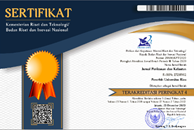PEMANFAATAN IKAN UNTUK MENGURANGI PENUMPUKAN MATERI ORGANIK DI BAWAH KARAMBA, PENELITIAN SKALA LABORATORIUM
(1)
(2)
(*) Corresponding Author
Abstract
A laboratory scaled study aims to understand the ability of several fish speciesin reducing the amount of organic materials accumulated around floating cage fishculture has been conducted in the Fishery and Marine Science Faculty, RiauUniversity, Pekanbaru from August to December 2008. Fingerlings (15-20 cm SL) ofNile tilapia (Oreochromis niloticus) were caged (6 fishes/ cage) and each cage was keptin the 25 liter aquarium. Outside the cages, other fishes namely common carp(Cyprinus carpio), Nile tilapia (O. niloticus ) and Catfish (Clarias batracus) werereared, 3 fishes/ aquarium. As controls, Nile tilapia were kept in the cages and therewas no fish out side the floating cage. Fishes were feed on fish pellet, 40% of cagedfish body weight, once/ day. Feed remains that are flown to the outside of the cage.Sediment accumulated was removed once/week for a 3 weeks period, then they werefiltered and dried in the 40o oven and was weighed. The fishes, however, were weightin the 1st day and by the end of the experiment and the feed conversion rate wascalculated.Results indicated that the sediment in the nile-carp aquarium is 1,67 gram; thenile-nile is 1.79 gram, the nile-catfish is 1.54 gram and the control is 2.28 gram.While the FCR of the nile-carp is 1.47; nile-nile is 1.04; nile-catfish is 1.05 andcontrol is 3.16. So, it can be concluded that the presence of fishes outside the cagereduce the amount of sediment accumulated around the cage and increase theefficiency of feed given to the fish.
Keywords
Floating cage; FCR; organic materials accumulation
Full Text:
PDFArticle Metrics
Abstract view : 124 timesPDF - 250 times
DOI: http://dx.doi.org/10.31258/jpk.14.02.%25p
Copyright (c) 2009 Jurnal Perikanan dan Kelautan
Gedung Marine Center Lt 2. Fakultas Perikanan dan Kelautan Universitas Riau



